You were recently hired as an entry-level bookkeeper for a service business that recently opened. This is the first month in operation for the

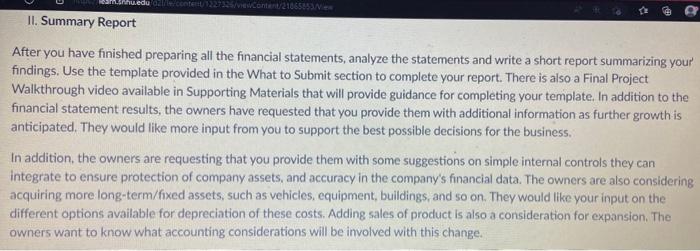
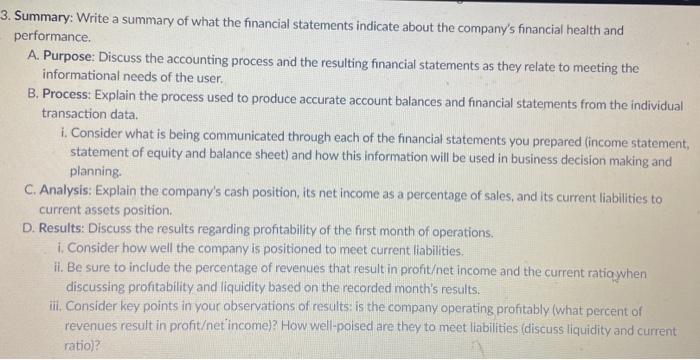

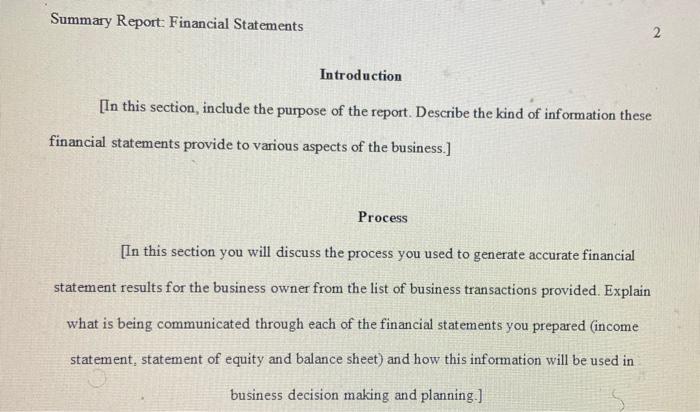
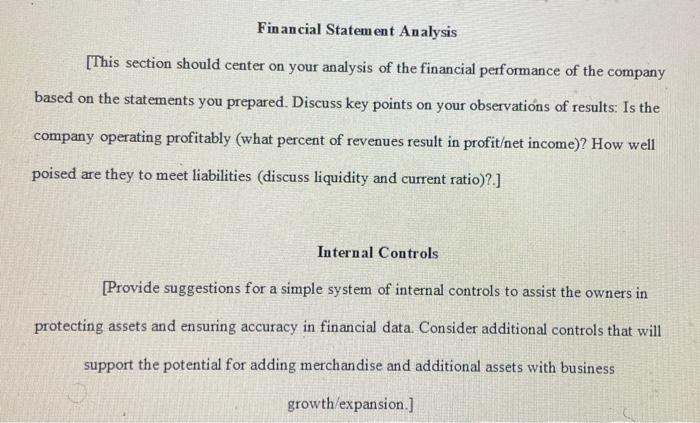
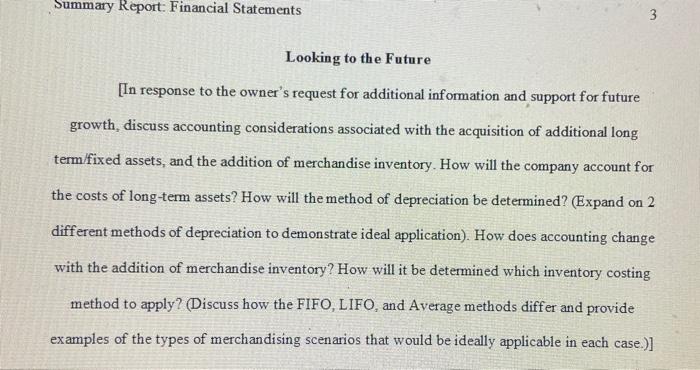
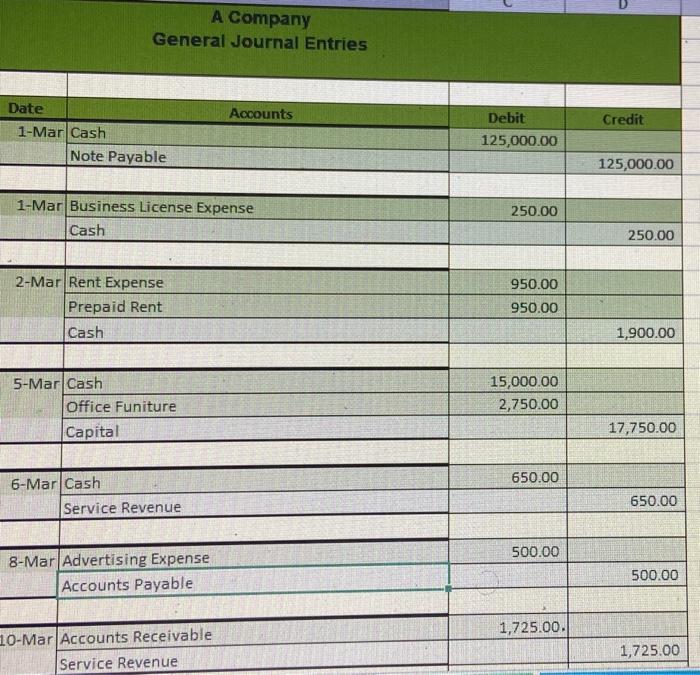
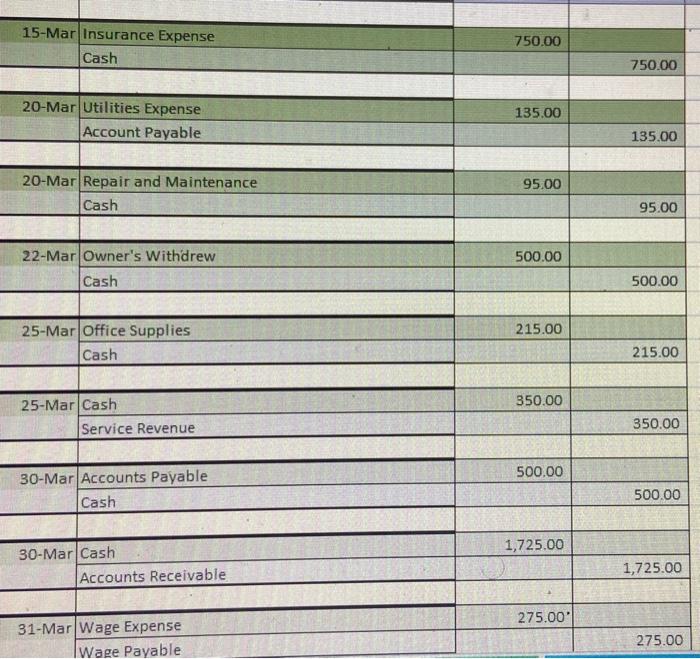

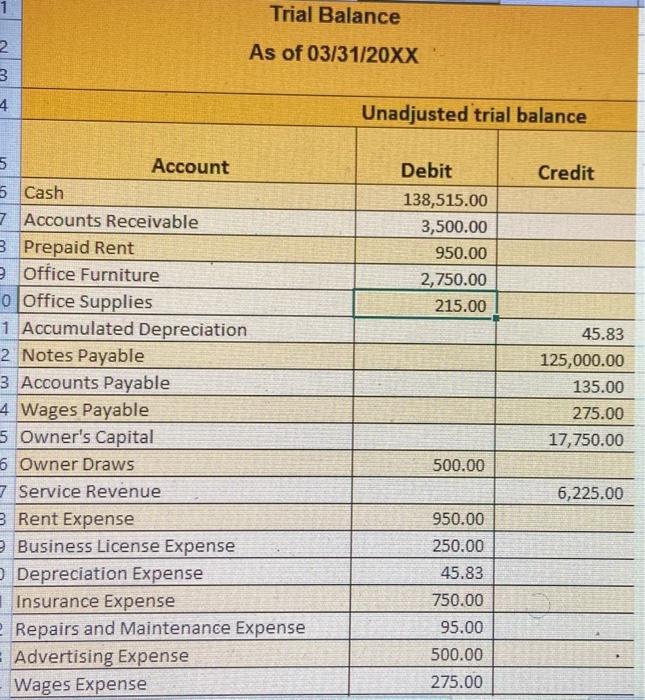

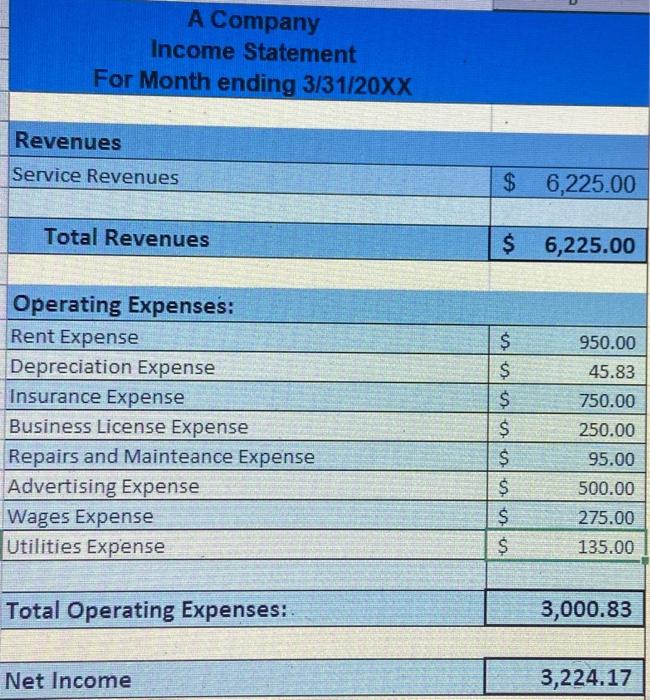
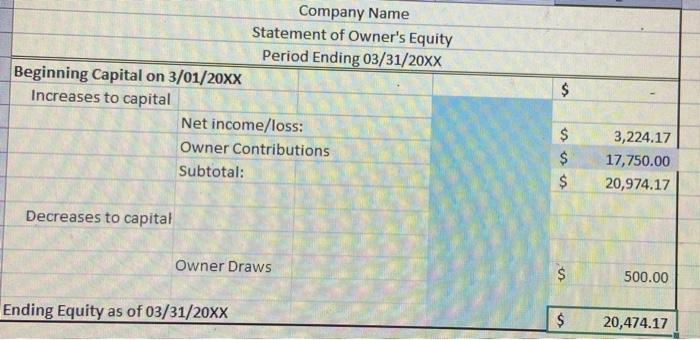
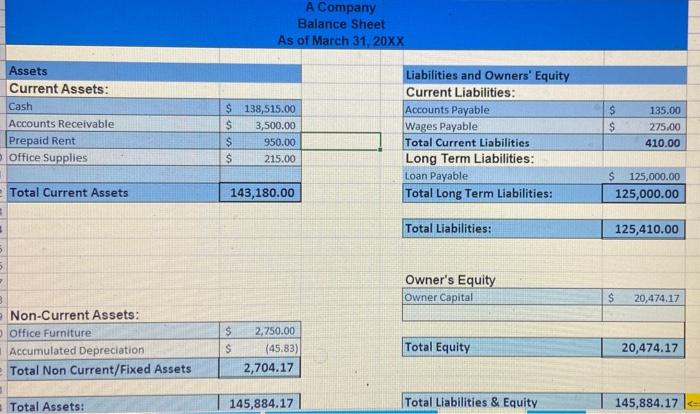
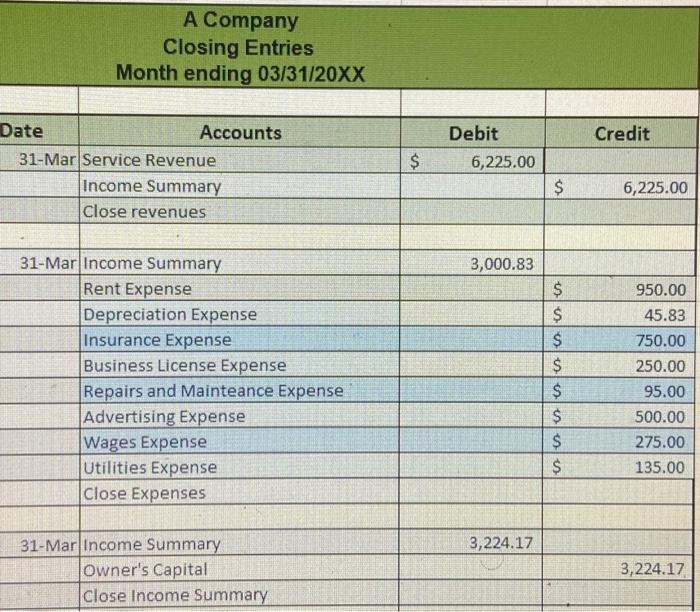


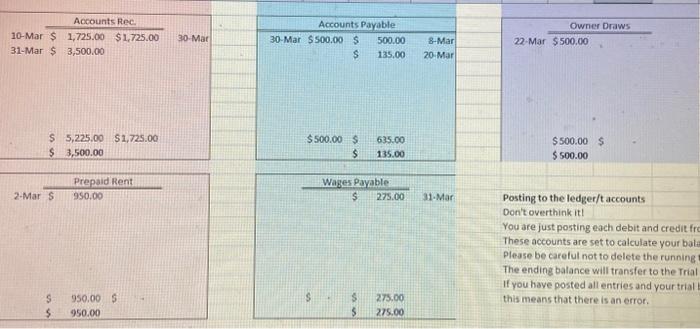
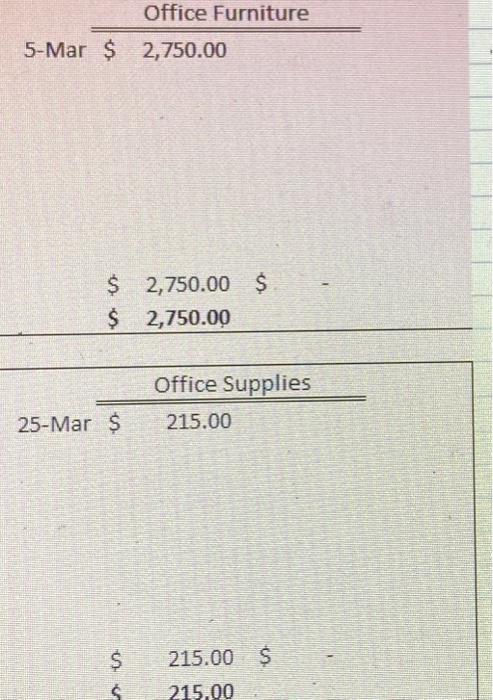
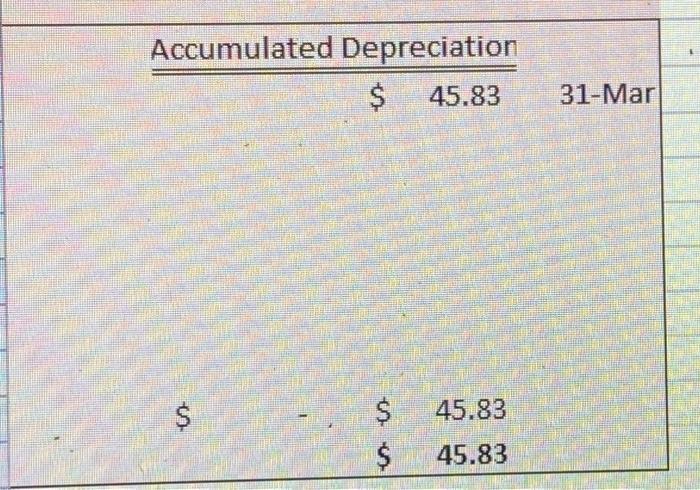
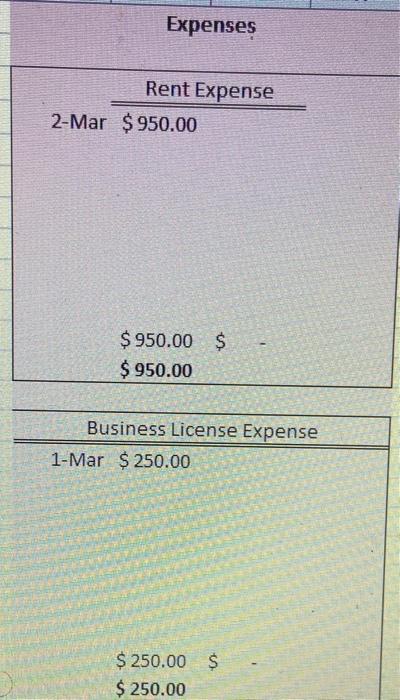

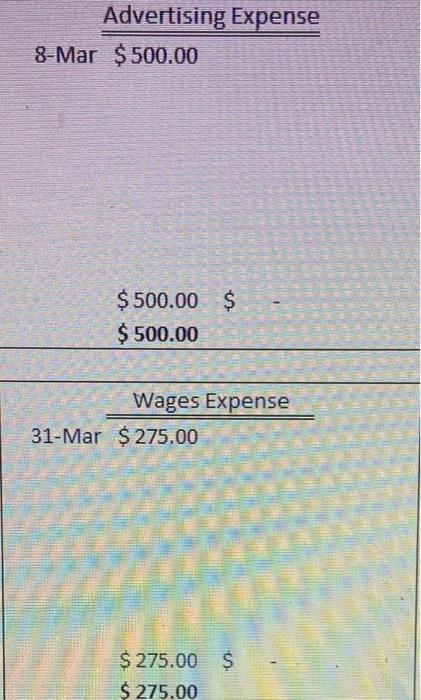
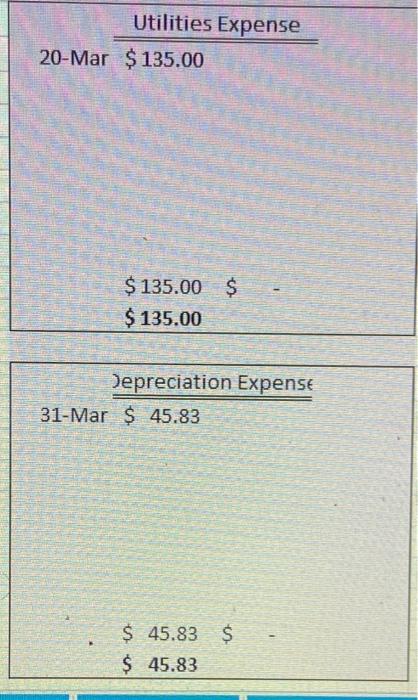
You were recently hired as an entry-level bookkeeper for a service business that recently opened. This is the first month in operation for the business and your first task is to record business transactions for their first month using the source documents and transaction data the owner will provide to you. Because this is a small business that does not use computerized accounting. you will apply the accounting cycle in Excel to record transactions and generate financial reporting results for the owner. Ram.Ahu.edu/az/e/cont Content/21865853/ II. Summary Report After you have finished preparing all the financial statements, analyze the statements and write a short report summarizing your findings. Use the template provided in the What to Submit section to complete your report. There is also a Final Project Walkthrough video available in Supporting Materials that will provide guidance for completing your template. In addition to the financial statement results, the owners have requested that you provide them with additional information as further growth is anticipated. They would like more input from you to support the best possible decisions for the business. In addition, the owners are requesting that you provide them with some suggestions on simple internal controls they can integrate to ensure protection of company assets, and accuracy in the company's financial data. The owners are also considering acquiring more long-term/fixed assets, such as vehicles, equipment, buildings, and so on. They would like your input on the different options available for depreciation of these costs. Adding sales of product is also a consideration for expansion. The owners want to know what accounting considerations will be involved with this change. 3. Summary: Write a summary of what the financial statements indicate about the company's financial health and performance. A. Purpose: Discuss the accounting process and the resulting financial statements as they relate to meeting the informational needs of the user. B. Process: Explain the process used to produce accurate account balances and financial statements from the individual transaction data. i. Consider what is being communicated through each of the financial statements you prepared (income statement, statement of equity and balance sheet) and how this information will be used in business decision making and planning. C. Analysis: Explain the company's cash position, its net income as a percentage of sales, and its current liabilities to current assets position. D. Results: Discuss the results regarding profitability of the first month of operations. i. Consider how well the company is positioned to meet current liabilities. ii. Be sure to include the percentage of revenues that result in profit/net income and the current ratio when discussing profitability and liquidity based on the recorded month's results. iii. Consider key points in your observations of results: is the company operating profitably (what percent of revenues result in profit/net'income)? How well-poised are they to meet liabilities (discuss liquidity and current ratio)? E. Recommendations: Recommend a simple system of controls that can be implemented to ensure protection of company assets and the accuracy and integrity of their financial data as they anticipate further growth. i. Consider additional controls that will support the potential for adding merchandise and additional assets with business growth/expansion. F. Asset Valuation: Discuss the treatment of current and long-term assets on the balance sheet. i. Discuss at least two different methods of depreciation. Consider how the methods of depreciation will be determined. ii. Discuss how LIFO. FIFO, and average methods will differ and provide examples of types of applicable merchandising. iii. Consider how accounting will change with the addition of merchandise inventory. Summary Report: Financial Statements Introduction [In this section, include the purpose of the report. Describe the kind of information these financial statements provide to various aspects of the business.] Process 2 [In this section you will discuss the process you used to generate accurate financial statement results for the business owner from the list of business transactions provided. Explain what is being communicated through each of the financial statements you prepared (income statement, statement of equity and balance sheet) and how this information will be used in business decision making and planning.] Financial Statement Analysis [This section should center on your analysis of the financial performance of the company based on the statements you prepared. Discuss key points on your observations of results: Is the company operating profitably (what percent of revenues result in profit/net income)? How well poised are they to meet liabilities (discuss liquidity and current ratio)?.] Internal Controls [Provide suggestions for a simple system of internal controls to assist the owners in protecting assets and ensuring accuracy in financial data. Consider additional controls that will support the potential for adding merchandise and additional assets with business growth/expansion.] Summary Report: Financial Statements 3 Looking to the Future [In response to the owner's request for additional information and support for future growth, discuss accounting considerations associated with the acquisition of additional long term/fixed assets, and the addition of merchandise inventory. How will the company account for the costs of long-term assets? How will the method of depreciation be determined? (Expand on 2 different methods of depreciation to demonstrate ideal application). How does accounting change with the addition of merchandise inventory? How will it be determined which inventory costing method to apply? (Discuss how the FIFO, LIFO, and Average methods differ and provide examples of the types of merchandising scenarios that would be ideally applicable in each case.)] Date 1-Mar Cash Note Payable A Company General Journal Entries 1-Mar Business License Expense Cash 2-Mar Rent Expense Prepaid Rent Cash 5-Mar Cash Office Funiture Capital 6-Mar Cash Service Revenue 8-Mar Advertising Expense Accounts Payable Accounts 10-Mar Accounts Receivable Service Revenue Debit 125,000.00 250.00 950.00 950.00 15,000.00 2,750.00 650.00 500.00 1,725.00. Credit 125,000.00 250.00 1,900.00 17,750.00 650.00 500.00 1,725.00 15-Mar Insurance Expense Cash 20-Mar Utilities Expense Account Payable 20-Mar Repair and Maintenance Cash 22-Mar Owner's Withdrew Cash 25-Mar Office Supplies Cash 25-Mar Cash Service Revenue 30-Mar Accounts Payable Cash 30-Mar Cash Accounts Receivable 31-Mar Wage Expense Wage Payable 750.00 135.00 95.00 500.00 215.00 350.00 500.00 1,725.00 275.00 750.00 135.00 95.00 500.00 215.00 350.00 500.00 1,725.00 275.00 31-Mar Account Receivable Service Revenue 31-Mar Depreciation Expense Accumulated Depreciation Total 3,500.00 45.83 155,865.83 3,500.00 45.83 155,865.83 If i 2 3 4 5 5 Cash 7 Accounts Receivable 3 Prepaid Rent e Office Furniture Account 0 Office Supplies 1 Accumulated Depreciation 2 Notes Payable 3 Accounts Payable Trial Balance As of 03/31/20XX 4 Wages Payable 5 Owner's Capital 6 Owner Draws 7 Service Revenue 3 Rent Expense e Business License Expense O Depreciation Expense Insurance Expense 2 Repairs and Maintenance Expense Advertising Expense Wages Expense Unadjusted trial balance Debit 138,515.00 3,500.00 950.00 2,750.00 215.00 500.00 950.00 250.00 45.83 750.00 95.00 500.00 275.00 Credit 45.83 125,000.00 135.00 275.00 17,750.00 6,225.00 5 Utilities Expense 7 Total: B A B 135.00 149,430.83 C 149,430.83 A Company Income Statement For Month ending 3/31/20XX Revenues Service Revenues Total Revenues Operating Expenses: Rent Expense Depreciation Expense Insurance Expense Business License Expense Repairs and Mainteance Expense Advertising Expense Wages Expense Utilities Expense Total Operating Expenses:. Net Income $ 6,225.00 $ 6,225.00 $ $ $ $ $ $ D $ 950.00 45.83 750.00 250.00 95.00 500.00 275.00 135.00 3,000.83 3,224.17 Beginning Capital on 3/01/20XX Increases to capital Decreases to capital Company Name Statement of Owner's Equity Period Ending 03/31/20XX Net income/loss: Owner Contributions Subtotal: Owner Draws Ending Equity as of 03/31/20XX $ $ $ $ es $ $ 3,224.17 17,750.00 20,974.17 500.00 20,474.17 5 3 Assets Current Assets: Cash Accounts Receivable Prepaid Rent Office Supplies Total Current Assets Non-Current Assets: O Office Furniture Accumulated Depreciation Total Non Current/Fixed Assets Total Assets: $ 138,515.00 $ 3,500.00 SSSS $ 950.00 215.00 $ A Company Balance Sheet As of March 31, 20XX 143,180.00 $ $ 2,750.00 (45.83) 2,704.17 145,884.17 Liabilities and Owners' Equity Current Liabilities: Accounts Payable Wages Payable Total Current Liabilities Long Term Liabilities: Loan Payable Total Long Term Liabilities: Total Liabilities: Owner's Equity Owner Capital Total Equity Total Liabilities & Equity $ $ 135.00 275.00 410.00 $ 125,000.00 125,000.00 125,410.00 $ 20,474.17 20,474.17 145,884.17 A Company Closing Entries Month ending 03/31/20XX Date 31-Mar Service Revenue Income Summary Close revenues Accounts 31-Mar Income Summary Rent Expense Depreciation Expense Insurance Expense Business License Expense Repairs and Mainteance Expense Advertising Expense Wages Expense Utilities Expense Close Expenses 31-Mar Income Summary Owner's Capital Close Income Summary $ Debit 6,225.00 3,000.83 3,224.17 $ $ es $ SSS is is ess $ $ $ $ $ $ Credit 6,225.00 950.00 45.83 750.00 250.00 95.00 500.00 275.00 135.00 3,224.17 31-Mar Owner's Capital Owner's Draws Close Owner Draws 500.00 12,950.00 500.00 12,950.00 Assets Cash 1-Mar $125,000.00 $ 250.00 6-May 5 Mar $15,000.00 $1,900.00 2-Mar 15-Mar 6 Mar S 25-Mar 5 20-Mar 22-Mar 25-Mar 30-Mar 750.00 650.00 350.00 $ 55.00 30 Mar $1,725.00 $ 500.00 $ 215.00 $ 500.00 $142,725.00 $4,210.00 $138,515.00 Accounts Rec. 10-Mar S 1,725.00 $1,725.00 30-Mar 31-Mar $ 3.500.00 $ 5,225.00 $1,725.00 $ 1,500.00 $ G H Liabilities Notes Payable $125,000.00 $125,000.00 $125,000.00 Accounts Payable 30-Mar $500.00 $ 500.00 $ 135.00 $500.00 $ $ 635.00 135.00 1-Mar 8-Mar 20-Mar S Equity Owner's Capital $17,750.00 22-Mar $500.00 $17,750.00 $17.750.00 Owner Draws $500.00 $ $ 500.00 5-Mar O Q S Revenue Service Revenue $ 600.00 6 Ma $1,725.00 10 Ma $ 150,00 25-Mar $1,500.00 11-Mar $6,225.00 $6,225.00 Accounts Rec. 10-Mar $ 1,725.00 $1,725.00 30-Mar 31-Mar $ 3,500.00 $ 5,225.00 $1,725.00 $ 3,500.00 Prepaid Rent 2-Mar S 950.00 55 950.00 $ 950.00 Accounts Payable 30-Mar $500.00 $ $ $500.00 $ 635.00 $ 135.00 500.00 8-Mar 135.00 20-Mar Wages Payable $ 275.00 31-Mari $ 55 275.00 275.00 Owner Draws 22-Mar $500.00 $500.00 $ $ 500.00 Posting to the ledger/t accounts Don't overthink it! You are just posting each debit and credit fre These accounts are set to calculate your bala Please be careful not to delete the running t The ending balance will transfer to the Trial If you have posted all entries and your trial b this means that there is an error. 5-Mar $ 2,750.00 $ $ 25-Mar $ $ Office Furniture 2,750.00 $ 2,750.00 Office Supplies 215.00 215.00 $ 215.00 Accumulated Depreciation $ $ 45.83 31-Mar $ $ 45.83 45.83 Expenses Rent Expense 2-Mar $950.00 $950.00 $ $ 950.00 Business License Expense 1-Mar $250.00 $ 250.00 $ $ 250.00 y. Insurance Expense 15-Mar $750.00 $750.00 $ $ 750.00 Repairs & Maint. 20-Mar $750.00 $750.00 $ $ 750.00 Advertising Expense 8-Mar $500.00 $ 500.00 $ $ 500.00 Wages Expense 31-Mar $275.00 $275.00 $ $ 275.00 Utilities Expense 20-Mar $135.00 $135.00 $ $ 135.00 Depreciation Expense 31-Mar $ 45.83 $ 45.83 $ $ 45.83 You were recently hired as an entry-level bookkeeper for a service business that recently opened. This is the first month in operation for the business and your first task is to record business transactions for their first month using the source documents and transaction data the owner will provide to you. Because this is a small business that does not use computerized accounting. you will apply the accounting cycle in Excel to record transactions and generate financial reporting results for the owner. Ram.Ahu.edu/az/e/cont Content/21865853/ II. Summary Report After you have finished preparing all the financial statements, analyze the statements and write a short report summarizing your findings. Use the template provided in the What to Submit section to complete your report. There is also a Final Project Walkthrough video available in Supporting Materials that will provide guidance for completing your template. In addition to the financial statement results, the owners have requested that you provide them with additional information as further growth is anticipated. They would like more input from you to support the best possible decisions for the business. In addition, the owners are requesting that you provide them with some suggestions on simple internal controls they can integrate to ensure protection of company assets, and accuracy in the company's financial data. The owners are also considering acquiring more long-term/fixed assets, such as vehicles, equipment, buildings, and so on. They would like your input on the different options available for depreciation of these costs. Adding sales of product is also a consideration for expansion. The owners want to know what accounting considerations will be involved with this change. 3. Summary: Write a summary of what the financial statements indicate about the company's financial health and performance. A. Purpose: Discuss the accounting process and the resulting financial statements as they relate to meeting the informational needs of the user. B. Process: Explain the process used to produce accurate account balances and financial statements from the individual transaction data. i. Consider what is being communicated through each of the financial statements you prepared (income statement, statement of equity and balance sheet) and how this information will be used in business decision making and planning. C. Analysis: Explain the company's cash position, its net income as a percentage of sales, and its current liabilities to current assets position. D. Results: Discuss the results regarding profitability of the first month of operations. i. Consider how well the company is positioned to meet current liabilities. ii. Be sure to include the percentage of revenues that result in profit/net income and the current ratio when discussing profitability and liquidity based on the recorded month's results. iii. Consider key points in your observations of results: is the company operating profitably (what percent of revenues result in profit/net'income)? How well-poised are they to meet liabilities (discuss liquidity and current ratio)? E. Recommendations: Recommend a simple system of controls that can be implemented to ensure protection of company assets and the accuracy and integrity of their financial data as they anticipate further growth. i. Consider additional controls that will support the potential for adding merchandise and additional assets with business growth/expansion. F. Asset Valuation: Discuss the treatment of current and long-term assets on the balance sheet. i. Discuss at least two different methods of depreciation. Consider how the methods of depreciation will be determined. ii. Discuss how LIFO. FIFO, and average methods will differ and provide examples of types of applicable merchandising. iii. Consider how accounting will change with the addition of merchandise inventory. Summary Report: Financial Statements Introduction [In this section, include the purpose of the report. Describe the kind of information these financial statements provide to various aspects of the business.] Process 2 [In this section you will discuss the process you used to generate accurate financial statement results for the business owner from the list of business transactions provided. Explain what is being communicated through each of the financial statements you prepared (income statement, statement of equity and balance sheet) and how this information will be used in business decision making and planning.] Financial Statement Analysis [This section should center on your analysis of the financial performance of the company based on the statements you prepared. Discuss key points on your observations of results: Is the company operating profitably (what percent of revenues result in profit/net income)? How well poised are they to meet liabilities (discuss liquidity and current ratio)?.] Internal Controls [Provide suggestions for a simple system of internal controls to assist the owners in protecting assets and ensuring accuracy in financial data. Consider additional controls that will support the potential for adding merchandise and additional assets with business growth/expansion.] Summary Report: Financial Statements 3 Looking to the Future [In response to the owner's request for additional information and support for future growth, discuss accounting considerations associated with the acquisition of additional long term/fixed assets, and the addition of merchandise inventory. How will the company account for the costs of long-term assets? How will the method of depreciation be determined? (Expand on 2 different methods of depreciation to demonstrate ideal application). How does accounting change with the addition of merchandise inventory? How will it be determined which inventory costing method to apply? (Discuss how the FIFO, LIFO, and Average methods differ and provide examples of the types of merchandising scenarios that would be ideally applicable in each case.)] Date 1-Mar Cash Note Payable A Company General Journal Entries 1-Mar Business License Expense Cash 2-Mar Rent Expense Prepaid Rent Cash 5-Mar Cash Office Funiture Capital 6-Mar Cash Service Revenue 8-Mar Advertising Expense Accounts Payable Accounts 10-Mar Accounts Receivable Service Revenue Debit 125,000.00 250.00 950.00 950.00 15,000.00 2,750.00 650.00 500.00 1,725.00. Credit 125,000.00 250.00 1,900.00 17,750.00 650.00 500.00 1,725.00 15-Mar Insurance Expense Cash 20-Mar Utilities Expense Account Payable 20-Mar Repair and Maintenance Cash 22-Mar Owner's Withdrew Cash 25-Mar Office Supplies Cash 25-Mar Cash Service Revenue 30-Mar Accounts Payable Cash 30-Mar Cash Accounts Receivable 31-Mar Wage Expense Wage Payable 750.00 135.00 95.00 500.00 215.00 350.00 500.00 1,725.00 275.00 750.00 135.00 95.00 500.00 215.00 350.00 500.00 1,725.00 275.00 31-Mar Account Receivable Service Revenue 31-Mar Depreciation Expense Accumulated Depreciation Total 3,500.00 45.83 155,865.83 3,500.00 45.83 155,865.83 If i 2 3 4 5 5 Cash 7 Accounts Receivable 3 Prepaid Rent e Office Furniture Account 0 Office Supplies 1 Accumulated Depreciation 2 Notes Payable 3 Accounts Payable Trial Balance As of 03/31/20XX 4 Wages Payable 5 Owner's Capital 6 Owner Draws 7 Service Revenue 3 Rent Expense e Business License Expense O Depreciation Expense Insurance Expense 2 Repairs and Maintenance Expense Advertising Expense Wages Expense Unadjusted trial balance Debit 138,515.00 3,500.00 950.00 2,750.00 215.00 500.00 950.00 250.00 45.83 750.00 95.00 500.00 275.00 Credit 45.83 125,000.00 135.00 275.00 17,750.00 6,225.00 5 Utilities Expense 7 Total: B A B 135.00 149,430.83 C 149,430.83 A Company Income Statement For Month ending 3/31/20XX Revenues Service Revenues Total Revenues Operating Expenses: Rent Expense Depreciation Expense Insurance Expense Business License Expense Repairs and Mainteance Expense Advertising Expense Wages Expense Utilities Expense Total Operating Expenses:. Net Income $ 6,225.00 $ 6,225.00 $ $ $ $ $ $ D $ 950.00 45.83 750.00 250.00 95.00 500.00 275.00 135.00 3,000.83 3,224.17 Beginning Capital on 3/01/20XX Increases to capital Decreases to capital Company Name Statement of Owner's Equity Period Ending 03/31/20XX Net income/loss: Owner Contributions Subtotal: Owner Draws Ending Equity as of 03/31/20XX $ $ $ $ es $ $ 3,224.17 17,750.00 20,974.17 500.00 20,474.17 5 3 Assets Current Assets: Cash Accounts Receivable Prepaid Rent Office Supplies Total Current Assets Non-Current Assets: O Office Furniture Accumulated Depreciation Total Non Current/Fixed Assets Total Assets: $ 138,515.00 $ 3,500.00 SSSS $ 950.00 215.00 $ A Company Balance Sheet As of March 31, 20XX 143,180.00 $ $ 2,750.00 (45.83) 2,704.17 145,884.17 Liabilities and Owners' Equity Current Liabilities: Accounts Payable Wages Payable Total Current Liabilities Long Term Liabilities: Loan Payable Total Long Term Liabilities: Total Liabilities: Owner's Equity Owner Capital Total Equity Total Liabilities & Equity $ $ 135.00 275.00 410.00 $ 125,000.00 125,000.00 125,410.00 $ 20,474.17 20,474.17 145,884.17 A Company Closing Entries Month ending 03/31/20XX Date 31-Mar Service Revenue Income Summary Close revenues Accounts 31-Mar Income Summary Rent Expense Depreciation Expense Insurance Expense Business License Expense Repairs and Mainteance Expense Advertising Expense Wages Expense Utilities Expense Close Expenses 31-Mar Income Summary Owner's Capital Close Income Summary $ Debit 6,225.00 3,000.83 3,224.17 $ $ es $ SSS is is ess $ $ $ $ $ $ Credit 6,225.00 950.00 45.83 750.00 250.00 95.00 500.00 275.00 135.00 3,224.17 31-Mar Owner's Capital Owner's Draws Close Owner Draws 500.00 12,950.00 500.00 12,950.00 Assets Cash 1-Mar $125,000.00 $ 250.00 6-May 5 Mar $15,000.00 $1,900.00 2-Mar 15-Mar 6 Mar S 25-Mar 5 20-Mar 22-Mar 25-Mar 30-Mar 750.00 650.00 350.00 $ 55.00 30 Mar $1,725.00 $ 500.00 $ 215.00 $ 500.00 $142,725.00 $4,210.00 $138,515.00 Accounts Rec. 10-Mar S 1,725.00 $1,725.00 30-Mar 31-Mar $ 3.500.00 $ 5,225.00 $1,725.00 $ 1,500.00 $ G H Liabilities Notes Payable $125,000.00 $125,000.00 $125,000.00 Accounts Payable 30-Mar $500.00 $ 500.00 $ 135.00 $500.00 $ $ 635.00 135.00 1-Mar 8-Mar 20-Mar S Equity Owner's Capital $17,750.00 22-Mar $500.00 $17,750.00 $17.750.00 Owner Draws $500.00 $ $ 500.00 5-Mar O Q S Revenue Service Revenue $ 600.00 6 Ma $1,725.00 10 Ma $ 150,00 25-Mar $1,500.00 11-Mar $6,225.00 $6,225.00 Accounts Rec. 10-Mar $ 1,725.00 $1,725.00 30-Mar 31-Mar $ 3,500.00 $ 5,225.00 $1,725.00 $ 3,500.00 Prepaid Rent 2-Mar S 950.00 55 950.00 $ 950.00 Accounts Payable 30-Mar $500.00 $ $ $500.00 $ 635.00 $ 135.00 500.00 8-Mar 135.00 20-Mar Wages Payable $ 275.00 31-Mari $ 55 275.00 275.00 Owner Draws 22-Mar $500.00 $500.00 $ $ 500.00 Posting to the ledger/t accounts Don't overthink it! You are just posting each debit and credit fre These accounts are set to calculate your bala Please be careful not to delete the running t The ending balance will transfer to the Trial If you have posted all entries and your trial b this means that there is an error. 5-Mar $ 2,750.00 $ $ 25-Mar $ $ Office Furniture 2,750.00 $ 2,750.00 Office Supplies 215.00 215.00 $ 215.00 Accumulated Depreciation $ $ 45.83 31-Mar $ $ 45.83 45.83 Expenses Rent Expense 2-Mar $950.00 $950.00 $ $ 950.00 Business License Expense 1-Mar $250.00 $ 250.00 $ $ 250.00 y. Insurance Expense 15-Mar $750.00 $750.00 $ $ 750.00 Repairs & Maint. 20-Mar $750.00 $750.00 $ $ 750.00 Advertising Expense 8-Mar $500.00 $ 500.00 $ $ 500.00 Wages Expense 31-Mar $275.00 $275.00 $ $ 275.00 Utilities Expense 20-Mar $135.00 $135.00 $ $ 135.00 Depreciation Expense 31-Mar $ 45.83 $ 45.83 $ $ 45.83 You were recently hired as an entry-level bookkeeper for a service business that recently opened. This is the first month in operation for the business and your first task is to record business transactions for their first month using the source documents and transaction data the owner will provide to you. Because this is a small business that does not use computerized accounting. you will apply the accounting cycle in Excel to record transactions and generate financial reporting results for the owner. Ram.Ahu.edu/az/e/cont Content/21865853/ II. Summary Report After you have finished preparing all the financial statements, analyze the statements and write a short report summarizing your findings. Use the template provided in the What to Submit section to complete your report. There is also a Final Project Walkthrough video available in Supporting Materials that will provide guidance for completing your template. In addition to the financial statement results, the owners have requested that you provide them with additional information as further growth is anticipated. They would like more input from you to support the best possible decisions for the business. In addition, the owners are requesting that you provide them with some suggestions on simple internal controls they can integrate to ensure protection of company assets, and accuracy in the company's financial data. The owners are also considering acquiring more long-term/fixed assets, such as vehicles, equipment, buildings, and so on. They would like your input on the different options available for depreciation of these costs. Adding sales of product is also a consideration for expansion. The owners want to know what accounting considerations will be involved with this change. 3. Summary: Write a summary of what the financial statements indicate about the company's financial health and performance. A. Purpose: Discuss the accounting process and the resulting financial statements as they relate to meeting the informational needs of the user. B. Process: Explain the process used to produce accurate account balances and financial statements from the individual transaction data. i. Consider what is being communicated through each of the financial statements you prepared (income statement, statement of equity and balance sheet) and how this information will be used in business decision making and planning. C. Analysis: Explain the company's cash position, its net income as a percentage of sales, and its current liabilities to current assets position. D. Results: Discuss the results regarding profitability of the first month of operations. i. Consider how well the company is positioned to meet current liabilities. ii. Be sure to include the percentage of revenues that result in profit/net income and the current ratio when discussing profitability and liquidity based on the recorded month's results. iii. Consider key points in your observations of results: is the company operating profitably (what percent of revenues result in profit/net'income)? How well-poised are they to meet liabilities (discuss liquidity and current ratio)? E. Recommendations: Recommend a simple system of controls that can be implemented to ensure protection of company assets and the accuracy and integrity of their financial data as they anticipate further growth. i. Consider additional controls that will support the potential for adding merchandise and additional assets with business growth/expansion. F. Asset Valuation: Discuss the treatment of current and long-term assets on the balance sheet. i. Discuss at least two different methods of depreciation. Consider how the methods of depreciation will be determined. ii. Discuss how LIFO. FIFO, and average methods will differ and provide examples of types of applicable merchandising. iii. Consider how accounting will change with the addition of merchandise inventory. Summary Report: Financial Statements Introduction [In this section, include the purpose of the report. Describe the kind of information these financial statements provide to various aspects of the business.] Process 2 [In this section you will discuss the process you used to generate accurate financial statement results for the business owner from the list of business transactions provided. Explain what is being communicated through each of the financial statements you prepared (income statement, statement of equity and balance sheet) and how this information will be used in business decision making and planning.] Financial Statement Analysis [This section should center on your analysis of the financial performance of the company based on the statements you prepared. Discuss key points on your observations of results: Is the company operating profitably (what percent of revenues result in profit/net income)? How well poised are they to meet liabilities (discuss liquidity and current ratio)?.] Internal Controls [Provide suggestions for a simple system of internal controls to assist the owners in protecting assets and ensuring accuracy in financial data. Consider additional controls that will support the potential for adding merchandise and additional assets with business growth/expansion.] Summary Report: Financial Statements 3 Looking to the Future [In response to the owner's request for additional information and support for future growth, discuss accounting considerations associated with the acquisition of additional long term/fixed assets, and the addition of merchandise inventory. How will the company account for the costs of long-term assets? How will the method of depreciation be determined? (Expand on 2 different methods of depreciation to demonstrate ideal application). How does accounting change with the addition of merchandise inventory? How will it be determined which inventory costing method to apply? (Discuss how the FIFO, LIFO, and Average methods differ and provide examples of the types of merchandising scenarios that would be ideally applicable in each case.)] Date 1-Mar Cash Note Payable A Company General Journal Entries 1-Mar Business License Expense Cash 2-Mar Rent Expense Prepaid Rent Cash 5-Mar Cash Office Funiture Capital 6-Mar Cash Service Revenue 8-Mar Advertising Expense Accounts Payable Accounts 10-Mar Accounts Receivable Service Revenue Debit 125,000.00 250.00 950.00 950.00 15,000.00 2,750.00 650.00 500.00 1,725.00. Credit 125,000.00 250.00 1,900.00 17,750.00 650.00 500.00 1,725.00 15-Mar Insurance Expense Cash 20-Mar Utilities Expense Account Payable 20-Mar Repair and Maintenance Cash 22-Mar Owner's Withdrew Cash 25-Mar Office Supplies Cash 25-Mar Cash Service Revenue 30-Mar Accounts Payable Cash 30-Mar Cash Accounts Receivable 31-Mar Wage Expense Wage Payable 750.00 135.00 95.00 500.00 215.00 350.00 500.00 1,725.00 275.00 750.00 135.00 95.00 500.00 215.00 350.00 500.00 1,725.00 275.00 31-Mar Account Receivable Service Revenue 31-Mar Depreciation Expense Accumulated Depreciation Total 3,500.00 45.83 155,865.83 3,500.00 45.83 155,865.83 If i 2 3 4 5 5 Cash 7 Accounts Receivable 3 Prepaid Rent e Office Furniture Account 0 Office Supplies 1 Accumulated Depreciation 2 Notes Payable 3 Accounts Payable Trial Balance As of 03/31/20XX 4 Wages Payable 5 Owner's Capital 6 Owner Draws 7 Service Revenue 3 Rent Expense e Business License Expense O Depreciation Expense Insurance Expense 2 Repairs and Maintenance Expense Advertising Expense Wages Expense Unadjusted trial balance Debit 138,515.00 3,500.00 950.00 2,750.00 215.00 500.00 950.00 250.00 45.83 750.00 95.00 500.00 275.00 Credit 45.83 125,000.00 135.00 275.00 17,750.00 6,225.00 5 Utilities Expense 7 Total: B A B 135.00 149,430.83 C 149,430.83 A Company Income Statement For Month ending 3/31/20XX Revenues Service Revenues Total Revenues Operating Expenses: Rent Expense Depreciation Expense Insurance Expense Business License Expense Repairs and Mainteance Expense Advertising Expense Wages Expense Utilities Expense Total Operating Expenses:. Net Income $ 6,225.00 $ 6,225.00 $ $ $ $ $ $ D $ 950.00 45.83 750.00 250.00 95.00 500.00 275.00 135.00 3,000.83 3,224.17 Beginning Capital on 3/01/20XX Increases to capital Decreases to capital Company Name Statement of Owner's Equity Period Ending 03/31/20XX Net income/loss: Owner Contributions Subtotal: Owner Draws Ending Equity as of 03/31/20XX $ $ $ $ es $ $ 3,224.17 17,750.00 20,974.17 500.00 20,474.17 5 3 Assets Current Assets: Cash Accounts Receivable Prepaid Rent Office Supplies Total Current Assets Non-Current Assets: O Office Furniture Accumulated Depreciation Total Non Current/Fixed Assets Total Assets: $ 138,515.00 $ 3,500.00 SSSS $ 950.00 215.00 $ A Company Balance Sheet As of March 31, 20XX 143,180.00 $ $ 2,750.00 (45.83) 2,704.17 145,884.17 Liabilities and Owners' Equity Current Liabilities: Accounts Payable Wages Payable Total Current Liabilities Long Term Liabilities: Loan Payable Total Long Term Liabilities: Total Liabilities: Owner's Equity Owner Capital Total Equity Total Liabilities & Equity $ $ 135.00 275.00 410.00 $ 125,000.00 125,000.00 125,410.00 $ 20,474.17 20,474.17 145,884.17 A Company Closing Entries Month ending 03/31/20XX Date 31-Mar Service Revenue Income Summary Close revenues Accounts 31-Mar Income Summary Rent Expense Depreciation Expense Insurance Expense Business License Expense Repairs and Mainteance Expense Advertising Expense Wages Expense Utilities Expense Close Expenses 31-Mar Income Summary Owner's Capital Close Income Summary $ Debit 6,225.00 3,000.83 3,224.17 $ $ es $ SSS is is ess $ $ $ $ $ $ Credit 6,225.00 950.00 45.83 750.00 250.00 95.00 500.00 275.00 135.00 3,224.17 31-Mar Owner's Capital Owner's Draws Close Owner Draws 500.00 12,950.00 500.00 12,950.00 Assets Cash 1-Mar $125,000.00 $ 250.00 6-May 5 Mar $15,000.00 $1,900.00 2-Mar 15-Mar 6 Mar S 25-Mar 5 20-Mar 22-Mar 25-Mar 30-Mar 750.00 650.00 350.00 $ 55.00 30 Mar $1,725.00 $ 500.00 $ 215.00 $ 500.00 $142,725.00 $4,210.00 $138,515.00 Accounts Rec. 10-Mar S 1,725.00 $1,725.00 30-Mar 31-Mar $ 3.500.00 $ 5,225.00 $1,725.00 $ 1,500.00 $ G H Liabilities Notes Payable $125,000.00 $125,000.00 $125,000.00 Accounts Payable 30-Mar $500.00 $ 500.00 $ 135.00 $500.00 $ $ 635.00 135.00 1-Mar 8-Mar 20-Mar S Equity Owner's Capital $17,750.00 22-Mar $500.00 $17,750.00 $17.750.00 Owner Draws $500.00 $ $ 500.00 5-Mar O Q S Revenue Service Revenue $ 600.00 6 Ma $1,725.00 10 Ma $ 150,00 25-Mar $1,500.00 11-Mar $6,225.00 $6,225.00 Accounts Rec. 10-Mar $ 1,725.00 $1,725.00 30-Mar 31-Mar $ 3,500.00 $ 5,225.00 $1,725.00 $ 3,500.00 Prepaid Rent 2-Mar S 950.00 55 950.00 $ 950.00 Accounts Payable 30-Mar $500.00 $ $ $500.00 $ 635.00 $ 135.00 500.00 8-Mar 135.00 20-Mar Wages Payable $ 275.00 31-Mari $ 55 275.00 275.00 Owner Draws 22-Mar $500.00 $500.00 $ $ 500.00 Posting to the ledger/t accounts Don't overthink it! You are just posting each debit and credit fre These accounts are set to calculate your bala Please be careful not to delete the running t The ending balance will transfer to the Trial If you have posted all entries and your trial b this means that there is an error. 5-Mar $ 2,750.00 $ $ 25-Mar $ $ Office Furniture 2,750.00 $ 2,750.00 Office Supplies 215.00 215.00 $ 215.00 Accumulated Depreciation $ $ 45.83 31-Mar $ $ 45.83 45.83 Expenses Rent Expense 2-Mar $950.00 $950.00 $ $ 950.00 Business License Expense 1-Mar $250.00 $ 250.00 $ $ 250.00 y. Insurance Expense 15-Mar $750.00 $750.00 $ $ 750.00 Repairs & Maint. 20-Mar $750.00 $750.00 $ $ 750.00 Advertising Expense 8-Mar $500.00 $ 500.00 $ $ 500.00 Wages Expense 31-Mar $275.00 $275.00 $ $ 275.00 Utilities Expense 20-Mar $135.00 $135.00 $ $ 135.00 Depreciation Expense 31-Mar $ 45.83 $ 45.83 $ $ 45.83 You were recently hired as an entry-level bookkeeper for a service business that recently opened. This is the first month in operation for the business and your first task is to record business transactions for their first month using the source documents and transaction data the owner will provide to you. Because this is a small business that does not use computerized accounting. you will apply the accounting cycle in Excel to record transactions and generate financial reporting results for the owner. Ram.Ahu.edu/az/e/cont Content/21865853/ II. Summary Report After you have finished preparing all the financial statements, analyze the statements and write a short report summarizing your findings. Use the template provided in the What to Submit section to complete your report. There is also a Final Project Walkthrough video available in Supporting Materials that will provide guidance for completing your template. In addition to the financial statement results, the owners have requested that you provide them with additional information as further growth is anticipated. They would like more input from you to support the best possible decisions for the business. In addition, the owners are requesting that you provide them with some suggestions on simple internal controls they can integrate to ensure protection of company assets, and accuracy in the company's financial data. The owners are also considering acquiring more long-term/fixed assets, such as vehicles, equipment, buildings, and so on. They would like your input on the different options available for depreciation of these costs. Adding sales of product is also a consideration for expansion. The owners want to know what accounting considerations will be involved with this change. 3. Summary: Write a summary of what the financial statements indicate about the company's financial health and performance. A. Purpose: Discuss the accounting process and the resulting financial statements as they relate to meeting the informational needs of the user. B. Process: Explain the process used to produce accurate account balances and financial statements from the individual transaction data. i. Consider what is being communicated through each of the financial statements you prepared (income statement, statement of equity and balance sheet) and how this information will be used in business decision making and planning. C. Analysis: Explain the company's cash position, its net income as a percentage of sales, and its current liabilities to current assets position. D. Results: Discuss the results regarding profitability of the first month of operations. i. Consider how well the company is positioned to meet current liabilities. ii. Be sure to include the percentage of revenues that result in profit/net income and the current ratio when discussing profitability and liquidity based on the recorded month's results. iii. Consider key points in your observations of results: is the company operating profitably (what percent of revenues result in profit/net'income)? How well-poised are they to meet liabilities (discuss liquidity and current ratio)? E. Recommendations: Recommend a simple system of controls that can be implemented to ensure protection of company assets and the accuracy and integrity of their financial data as they anticipate further growth. i. Consider additional controls that will support the potential for adding merchandise and additional assets with business growth/expansion. F. Asset Valuation: Discuss the treatment of current and long-term assets on the balance sheet. i. Discuss at least two different methods of depreciation. Consider how the methods of depreciation will be determined. ii. Discuss how LIFO. FIFO, and average methods will differ and provide examples of types of applicable merchandising. iii. Consider how accounting will change with the addition of merchandise inventory. Summary Report: Financial Statements Introduction [In this section, include the purpose of the report. Describe the kind of information these financial statements provide to various aspects of the business.] Process 2 [In this section you will discuss the process you used to generate accurate financial statement results for the business owner from the list of business transactions provided. Explain what is being communicated through each of the financial statements you prepared (income statement, statement of equity and balance sheet) and how this information will be used in business decision making and planning.] Financial Statement Analysis [This section should center on your analysis of the financial performance of the company based on the statements you prepared. Discuss key points on your observations of results: Is the company operating profitably (what percent of revenues result in profit/net income)? How well poised are they to meet liabilities (discuss liquidity and current ratio)?.] Internal Controls [Provide suggestions for a simple system of internal controls to assist the owners in protecting assets and ensuring accuracy in financial data. Consider additional controls that will support the potential for adding merchandise and additional assets with business growth/expansion.] Summary Report: Financial Statements 3 Looking to the Future [In response to the owner's request for additional information and support for future growth, discuss accounting considerations associated with the acquisition of additional long term/fixed assets, and the addition of merchandise inventory. How will the company account for the costs of long-term assets? How will the method of depreciation be determined? (Expand on 2 different methods of depreciation to demonstrate ideal application). How does accounting change with the addition of merchandise inventory? How will it be determined which inventory costing method to apply? (Discuss how the FIFO, LIFO, and Average methods differ and provide examples of the types of merchandising scenarios that would be ideally applicable in each case.)] Date 1-Mar Cash Note Payable A Company General Journal Entries 1-Mar Business License Expense Cash 2-Mar Rent Expense Prepaid Rent Cash 5-Mar Cash Office Funiture Capital 6-Mar Cash Service Revenue 8-Mar Advertising Expense Accounts Payable Accounts 10-Mar Accounts Receivable Service Revenue Debit 125,000.00 250.00 950.00 950.00 15,000.00 2,750.00 650.00 500.00 1,725.00. Credit 125,000.00 250.00 1,900.00 17,750.00 650.00 500.00 1,725.00 15-Mar Insurance Expense Cash 20-Mar Utilities Expense Account Payable 20-Mar Repair and Maintenance Cash 22-Mar Owner's Withdrew Cash 25-Mar Office Supplies Cash 25-Mar Cash Service Revenue 30-Mar Accounts Payable Cash 30-Mar Cash Accounts Receivable 31-Mar Wage Expense Wage Payable 750.00 135.00 95.00 500.00 215.00 350.00 500.00 1,725.00 275.00 750.00 135.00 95.00 500.00 215.00 350.00 500.00 1,725.00 275.00 31-Mar Account Receivable Service Revenue 31-Mar Depreciation Expense Accumulated Depreciation Total 3,500.00 45.83 155,865.83 3,500.00 45.83 155,865.83 If i 2 3 4 5 5 Cash 7 Accounts Receivable 3 Prepaid Rent e Office Furniture Account 0 Office Supplies 1 Accumulated Depreciation 2 Notes Payable 3 Accounts Payable Trial Balance As of 03/31/20XX 4 Wages Payable 5 Owner's Capital 6 Owner Draws 7 Service Revenue 3 Rent Expense e Business License Expense O Depreciation Expense Insurance Expense 2 Repairs and Maintenance Expense Advertising Expense Wages Expense Unadjusted trial balance Debit 138,515.00 3,500.00 950.00 2,750.00 215.00 500.00 950.00 250.00 45.83 750.00 95.00 500.00 275.00 Credit 45.83 125,000.00 135.00 275.00 17,750.00 6,225.00 5 Utilities Expense 7 Total: B A B 135.00 149,430.83 C 149,430.83 A Company Income Statement For Month ending 3/31/20XX Revenues Service Revenues Total Revenues Operating Expenses: Rent Expense Depreciation Expense Insurance Expense Business License Expense Repairs and Mainteance Expense Advertising Expense Wages Expense Utilities Expense Total Operating Expenses:. Net Income $ 6,225.00 $ 6,225.00 $ $ $ $ $ $ D $ 950.00 45.83 750.00 250.00 95.00 500.00 275.00 135.00 3,000.83 3,224.17 Beginning Capital on 3/01/20XX Increases to capital Decreases to capital Company Name Statement of Owner's Equity Period Ending 03/31/20XX Net income/loss: Owner Contributions Subtotal: Owner Draws Ending Equity as of 03/31/20XX $ $ $ $ es $ $ 3,224.17 17,750.00 20,974.17 500.00 20,474.17 5 3 Assets Current Assets: Cash Accounts Receivable Prepaid Rent Office Supplies Total Current Assets Non-Current Assets: O Office Furniture Accumulated Depreciation Total Non Current/Fixed Assets Total Assets: $ 138,515.00 $ 3,500.00 SSSS $ 950.00 215.00 $ A Company Balance Sheet As of March 31, 20XX 143,180.00 $ $ 2,750.00 (45.83) 2,704.17 145,884.17 Liabilities and Owners' Equity Current Liabilities: Accounts Payable Wages Payable Total Current Liabilities Long Term Liabilities: Loan Payable Total Long Term Liabilities: Total Liabilities: Owner's Equity Owner Capital Total Equity Total Liabilities & Equity $ $ 135.00 275.00 410.00 $ 125,000.00 125,000.00 125,410.00 $ 20,474.17 20,474.17 145,884.17 A Company Closing Entries Month ending 03/31/20XX Date 31-Mar Service Revenue Income Summary Close revenues Accounts 31-Mar Income Summary Rent Expense Depreciation Expense Insurance Expense Business License Expense Repairs and Mainteance Expense Advertising Expense Wages Expense Utilities Expense Close Expenses 31-Mar Income Summary Owner's Capital Close Income Summary $ Debit 6,225.00 3,000.83 3,224.17 $ $ es $ SSS is is ess $ $ $ $ $ $ Credit 6,225.00 950.00 45.83 750.00 250.00 95.00 500.00 275.00 135.00 3,224.17 31-Mar Owner's Capital Owner's Draws Close Owner Draws 500.00 12,950.00 500.00 12,950.00 Assets Cash 1-Mar $125,000.00 $ 250.00 6-May 5 Mar $15,000.00 $1,900.00 2-Mar 15-Mar 6 Mar S 25-Mar 5 20-Mar 22-Mar 25-Mar 30-Mar 750.00 650.00 350.00 $ 55.00 30 Mar $1,725.00 $ 500.00 $ 215.00 $ 500.00 $142,725.00 $4,210.00 $138,515.00 Accounts Rec. 10-Mar S 1,725.00 $1,725.00 30-Mar 31-Mar $ 3.500.00 $ 5,225.00 $1,725.00 $ 1,500.00 $ G H Liabilities Notes Payable $125,000.00 $125,000.00 $125,000.00 Accounts Payable 30-Mar $500.00 $ 500.00 $ 135.00 $500.00 $ $ 635.00 135.00 1-Mar 8-Mar 20-Mar S Equity Owner's Capital $17,750.00 22-Mar $500.00 $17,750.00 $17.750.00 Owner Draws $500.00 $ $ 500.00 5-Mar O Q S Revenue Service Revenue $ 600.00 6 Ma $1,725.00 10 Ma $ 150,00 25-Mar $1,500.00 11-Mar $6,225.00 $6,225.00 Accounts Rec. 10-Mar $ 1,725.00 $1,725.00 30-Mar 31-Mar $ 3,500.00 $ 5,225.00 $1,725.00 $ 3,500.00 Prepaid Rent 2-Mar S 950.00 55 950.00 $ 950.00 Accounts Payable 30-Mar $500.00 $ $ $500.00 $ 635.00 $ 135.00 500.00 8-Mar 135.00 20-Mar Wages Payable $ 275.00 31-Mari $ 55 275.00 275.00 Owner Draws 22-Mar $500.00 $500.00 $ $ 500.00 Posting to the ledger/t accounts Don't overthink it! You are just posting each debit and credit fre These accounts are set to calculate your bala Please be careful not to delete the running t The ending balance will transfer to the Trial If you have posted all entries and your trial b this means that there is an error. 5-Mar $ 2,750.00 $ $ 25-Mar $ $ Office Furniture 2,750.00 $ 2,750.00 Office Supplies 215.00 215.00 $ 215.00 Accumulated Depreciation $ $ 45.83 31-Mar $ $ 45.83 45.83 Expenses Rent Expense 2-Mar $950.00 $950.00 $ $ 950.00 Business License Expense 1-Mar $250.00 $ 250.00 $ $ 250.00 y. Insurance Expense 15-Mar $750.00 $750.00 $ $ 750.00 Repairs & Maint. 20-Mar $750.00 $750.00 $ $ 750.00 Advertising Expense 8-Mar $500.00 $ 500.00 $ $ 500.00 Wages Expense 31-Mar $275.00 $275.00 $ $ 275.00 Utilities Expense 20-Mar $135.00 $135.00 $ $ 135.00 Depreciation Expense 31-Mar $ 45.83 $ 45.83 $ $ 45.83 You were recently hired as an entry-level bookkeeper for a service business that recently opened. This is the first month in operation for the business and your first task is to record business transactions for their first month using the source documents and transaction data the owner will provide to you. Because this is a small business that does not use computerized accounting. you will apply the accounting cycle in Excel to record transactions and generate financial reporting results for the owner. Ram.Ahu.edu/az/e/cont Content/21865853/ II. Summary Report After you have finished preparing all the financial statements, analyze the statements and write a short report summarizing your findings. Use the template provided in the What to Submit section to complete your report. There is also a Final Project Walkthrough video available in Supporting Materials that will provide guidance for completing your template. In addition to the financial statement results, the owners have requested that you provide them with additional information as further growth is anticipated. They would like more input from you to support the best possible decisions for the business. In addition, the owners are requesting that you provide them with some suggestions on simple internal controls they can integrate to ensure protection of company assets, and accuracy in the company's financial data. The owners are also considering acquiring more long-term/fixed assets, such as vehicles, equipment, buildings, and so on. They would like your input on the different options available for depreciation of these costs. Adding sales of product is also a consideration for expansion. The owners want to know what accounting considerations will be involved with this change. 3. Summary: Write a summary of what the financial statements indicate about the company's financial health and performance. A. Purpose: Discuss the accounting process and the resulting financial statements as they relate to meeting the informational needs of the user. B. Process: Explain the process used to produce accurate account balances and financial statements from the individual transaction data. i. Consider what is being communicated through each of the financial statements you prepared (income statement, statement of equity and balance sheet) and how this information will be used in business decision making and planning. C. Analysis: Explain the company's cash position, its net income as a percentage of sales, and its current liabilities to current assets position. D. Results: Discuss the results regarding profitability of the first month of operations. i. Consider how well the company is positioned to meet current liabilities. ii. Be sure to include the percentage of revenues that result in profit/net income and the current ratio when discussing profitability and liquidity based on the recorded month's results. iii. Consider key points in your observations of results: is the company operating profitably (what percent of revenues result in profit/net'income)? How well-poised are they to meet liabilities (discuss liquidity and current ratio)? E. Recommendations: Recommend a simple system of controls that can be implemented to ensure protection of company assets and the accuracy and integrity of their financial data as they anticipate further growth. i. Consider additional controls that will support the potential for adding merchandise and additional assets with business growth/expansion. F. Asset Valuation: Discuss the treatment of current and long-term assets on the balance sheet. i. Discuss at least two different methods of depreciation. Consider how the methods of depreciation will be determined. ii. Discuss how LIFO. FIFO, and average methods will differ and provide examples of types of applicable merchandising. iii. Consider how accounting will change with the addition of merchandise inventory. Summary Report: Financial Statements Introduction [In this section, include the purpose of the report. Describe the kind of information these financial statements provide to various aspects of the business.] Process 2 [In this section you will discuss the process you used to generate accurate financial statement results for the business owner from the list of business transactions provided. Explain what is being communicated through each of the financial statements you prepared (income statement, statement of equity and balance sheet) and how this information will be used in business decision making and planning.] Financial Statement Analysis [This section should center on your analysis of the financial performance of the company based on the statements you prepared. Discuss key points on your observations of results: Is the company operating profitably (what percent of revenues result in profit/net income)? How well poised are they to meet liabilities (discuss liquidity and current ratio)?.] Internal Controls [Provide suggestions for a simple system of internal controls to assist the owners in protecting assets and ensuring accuracy in financial data. Consider additional controls that will support the potential for adding merchandise and additional assets with business growth/expansion.] Summary Report: Financial Statements 3 Looking to the Future [In response to the owner's request for additional information and support for future growth, discuss accounting considerations associated with the acquisition of additional long term/fixed assets, and the addition of merchandise inventory. How will the company account for the costs of long-term assets? How will the method of depreciation be determined? (Expand on 2 different methods of depreciation to demonstrate ideal application). How does accounting change with the addition of merchandise inventory? How will it be determined which inventory costing method to apply? (Discuss how the FIFO, LIFO, and Average methods differ and provide examples of the types of merchandising scenarios that would be ideally applicable in each case.)] Date 1-Mar Cash Note Payable A Company General Journal Entries 1-Mar Business License Expense Cash 2-Mar Rent Expense Prepaid Rent Cash 5-Mar Cash Office Funiture Capital 6-Mar Cash Service Revenue 8-Mar Advertising Expense Accounts Payable Accounts 10-Mar Accounts Receivable Service Revenue Debit 125,000.00 250.00 950.00 950.00 15,000.00 2,750.00 650.00 500.00 1,725.00. Credit 125,000.00 250.00 1,900.00 17,750.00 650.00 500.00 1,725.00 15-Mar Insurance Expense Cash 20-Mar Utilities Expense Account Payable 20-Mar Repair and Maintenance Cash 22-Mar Owner's Withdrew Cash 25-Mar Office Supplies Cash 25-Mar Cash Service Revenue 30-Mar Accounts Payable Cash 30-Mar Cash Accounts Receivable 31-Mar Wage Expense Wage Payable 750.00 135.00 95.00 500.00 215.00 350.00 500.00 1,725.00 275.00 750.00 135.00 95.00 500.00 215.00 350.00 500.00 1,725.00 275.00 31-Mar Account Receivable Service Revenue 31-Mar Depreciation Expense Accumulated Depreciation Total 3,500.00 45.83 155,865.83 3,500.00 45.83 155,865.83 If i 2 3 4 5 5 Cash 7 Accounts Receivable 3 Prepaid Rent e Office Furniture Account 0 Office Supplies 1 Accumulated Depreciation 2 Notes Payable 3 Accounts Payable Trial Balance As of 03/31/20XX 4 Wages Payable 5 Owner's Capital 6 Owner Draws 7 Service Revenue 3 Rent Expense e Business License Expense O Depreciation Expense Insurance Expense 2 Repairs and Maintenance Expense Advertising Expense Wages Expense Unadjusted trial balance Debit 138,515.00 3,500.00 950.00 2,750.00 215.00 500.00 950.00 250.00 45.83 750.00 95.00 500.00 275.00 Credit 45.83 125,000.00 135.00 275.00 17,750.00 6,225.00 5 Utilities Expense 7 Total: B A B 135.00 149,430.83 C 149,430.83 A Company Income Statement For Month ending 3/31/20XX Revenues Service Revenues Total Revenues Operating Expenses: Rent Expense Depreciation Expense Insurance Expense Business License Expense Repairs and Mainteance Expense Advertising Expense Wages Expense Utilities Expense Total Operating Expenses:. Net Income $ 6,225.00 $ 6,225.00 $ $ $ $ $ $ D $ 950.00 45.83 750.00 250.00 95.00 500.00 275.00 135.00 3,000.83 3,224.17 Beginning Capital on 3/01/20XX Increases to capital Decreases to capital Company Name Statement of Owner's Equity Period Ending 03/31/20XX Net income/loss: Owner Contributions Subtotal: Owner Draws Ending Equity as of 03/31/20XX $ $ $ $ es $ $ 3,224.17 17,750.00 20,974.17 500.00 20,474.17 5 3 Assets Current Assets: Cash Accounts Receivable Prepaid Rent Office Supplies Total Current Assets Non-Current Assets: O Office Furniture Accumulated Depreciation Total Non Current/Fixed Assets Total Assets: $ 138,515.00 $ 3,500.00 SSSS $ 950.00 215.00 $ A Company Balance Sheet As of March 31, 20XX 143,180.00 $ $ 2,750.00 (45.83) 2,704.17 145,884.17 Liabilities and Owners' Equity Current Liabilities: Accounts Payable Wages Payable Total Current Liabilities Long Term Liabilities: Loan Payable Total Long Term Liabilities: Total Liabilities: Owner's Equity Owner Capital Total Equity Total Liabilities & Equity $ $ 135.00 275.00 410.00 $ 125,000.00 125,000.00 125,410.00 $ 20,474.17 20,474.17 145,884.17 A Company Closing Entries Month ending 03/31/20XX Date 31-Mar Service Revenue Income Summary Close revenues Accounts 31-Mar Income Summary Rent Expense Depreciation Expense Insurance Expense Business License Expense Repairs and Mainteance Expense Advertising Expense Wages Expense Utilities Expense Close Expenses 31-Mar Income Summary Owner's Capital Close Income Summary $ Debit 6,225.00 3,000.83 3,224.17 $ $ es $ SSS is is ess $ $ $ $ $ $ Credit 6,225.00 950.00 45.83 750.00 250.00 95.00 500.00 275.00 135.00 3,224.17 31-Mar Owner's Capital Owner's Draws Close Owner Draws 500.00 12,950.00 500.00 12,950.00 Assets Cash 1-Mar $125,000.00 $ 250.00 6-May 5 Mar $15,000.00 $1,900.00 2-Mar 15-Mar 6 Mar S 25-Mar 5 20-Mar 22-Mar 25-Mar 30-Mar 750.00 650.00 350.00 $ 55.00 30 Mar $1,725.00 $ 500.00 $ 215.00 $ 500.00 $142,725.00 $4,210.00 $138,515.00 Accounts Rec. 10-Mar S 1,725.00 $1,725.00 30-Mar 31-Mar $ 3.500.00 $ 5,225.00 $1,725.00 $ 1,500.00 $ G H Liabilities Notes Payable $125,000.00 $125,000.00 $125,000.00 Accounts Payable 30-Mar $500.00 $ 500.00 $ 135.00 $500.00 $ $ 635.00 135.00 1-Mar 8-Mar 20-Mar S Equity Owner's Capital $17,750.00 22-Mar $500.00 $17,750.00 $17.750.00 Owner Draws $500.00 $ $ 500.00 5-Mar O Q S Revenue Service Revenue $ 600.00 6 Ma $1,725.00 10 Ma $ 150,00 25-Mar $1,500.00 11-Mar $6,225.00 $6,225.00 Accounts Rec. 10-Mar $ 1,725.00 $1,725.00 30-Mar 31-Mar $ 3,500.00 $ 5,225.00 $1,725.00 $ 3,500.00 Prepaid Rent 2-Mar S 950.00 55 950.00 $ 950.00 Accounts Payable 30-Mar $500.00 $ $ $500.00 $ 635.00 $ 135.00 500.00 8-Mar 135.00 20-Mar Wages Payable $ 275.00 31-Mari $ 55 275.00 275.00 Owner Draws 22-Mar $500.00 $500.00 $ $ 500.00 Posting to the ledger/t accounts Don't overthink it! You are just posting each debit and credit fre These accounts are set to calculate your bala Please be careful not to delete the running t The ending balance will transfer to the Trial If you have posted all entries and your trial b this means that there is an error. 5-Mar $ 2,750.00 $ $ 25-Mar $ $ Office Furniture 2,750.00 $ 2,750.00 Office Supplies 215.00 215.00 $ 215.00 Accumulated Depreciation $ $ 45.83 31-Mar $ $ 45.83 45.83 Expenses Rent Expense 2-Mar $950.00 $950.00 $ $ 950.00 Business License Expense 1-Mar $250.00 $ 250.00 $ $ 250.00 y. Insurance Expense 15-Mar $750.00 $750.00 $ $ 750.00 Repairs & Maint. 20-Mar $750.00 $750.00 $ $ 750.00 Advertising Expense 8-Mar $500.00 $ 500.00 $ $ 500.00 Wages Expense 31-Mar $275.00 $275.00 $ $ 275.00 Utilities Expense 20-Mar $135.00 $135.00 $ $ 135.00 Depreciation Expense 31-Mar $ 45.83 $ 45.83 $ $ 45.83
Step by Step Solution
3.51 Rating (175 Votes )
There are 3 Steps involved in it
Step: 1

See step-by-step solutions with expert insights and AI powered tools for academic success
Step: 2

Step: 3

Ace Your Homework with AI
Get the answers you need in no time with our AI-driven, step-by-step assistance
Get Started


